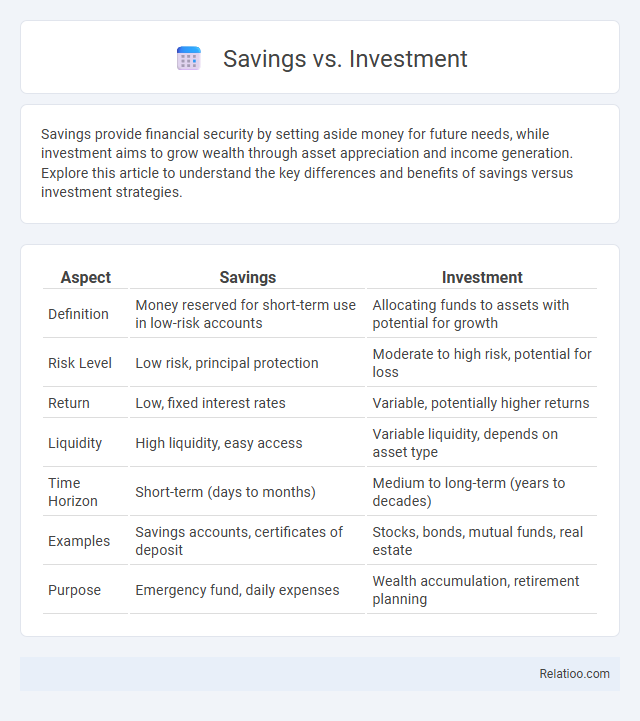Savings provide financial security by setting aside money for future needs, while investment aims to grow wealth through asset appreciation and income generation. Explore this article to understand the key differences and benefits of savings versus investment strategies.
Table of Comparison
| Aspect | Savings | Investment |
|---|---|---|
| Definition | Money reserved for short-term use in low-risk accounts | Allocating funds to assets with potential for growth |
| Risk Level | Low risk, principal protection | Moderate to high risk, potential for loss |
| Return | Low, fixed interest rates | Variable, potentially higher returns |
| Liquidity | High liquidity, easy access | Variable liquidity, depends on asset type |
| Time Horizon | Short-term (days to months) | Medium to long-term (years to decades) |
| Examples | Savings accounts, certificates of deposit | Stocks, bonds, mutual funds, real estate |
| Purpose | Emergency fund, daily expenses | Wealth accumulation, retirement planning |
Understanding Savings: Definition and Purpose
Savings refers to the portion of income set aside and not spent immediately, serving as a financial safety net for emergencies or future needs. It typically earns low interest and prioritizes liquidity and security over high returns. Savings accounts are essential for short-term goals, providing easy access to funds while preserving capital.
What is Investment? Key Concepts Explained
Investment involves allocating your money into assets such as stocks, bonds, or real estate with the goal of generating returns over time, distinguishing it from mere savings held in household accounts meant for short-term needs. Key concepts include risk tolerance, asset diversification, and expected rates of return, which influence the potential growth and volatility of your investment portfolio. Understanding these principles helps you make informed decisions to grow your wealth beyond the inflation-adjusted value of traditional savings.
Main Differences Between Savings and Investment
Savings typically refer to low-risk, easily accessible funds stored in household accounts for short-term needs or emergencies, often earning minimal interest. Investments involve allocating money into assets like stocks, bonds, or real estate, aiming for higher returns over a longer period with increased risk. The main difference lies in liquidity and risk: savings prioritize capital preservation and accessibility, while investments focus on growth potential with varying degrees of risk exposure.
Risk Factors: Savings vs Investment
Savings accounts offer low risk with guaranteed principal protection and easy access to funds, making them ideal for short-term financial needs and emergencies. Investments carry higher risk due to market fluctuations and potential loss of capital but provide opportunities for greater returns over time and wealth growth. Your choice between savings and investment depends on your risk tolerance, financial goals, and time horizon for accessing the money.
Liquidity and Accessibility Comparison
Savings accounts offer high liquidity and easy accessibility, making your funds readily available for emergencies or short-term needs. Investment accounts typically provide lower liquidity due to market fluctuations and potential lock-in periods but offer higher returns over time. Household accounts are generally used for managing daily expenses and bills, offering moderate liquidity with easy access through online banking platforms.
Potential Returns: Savings Versus Investment
Savings accounts typically offer lower interest rates with minimal risk, resulting in modest but stable potential returns ideal for short-term goals or emergency funds. Investments, such as stocks, bonds, or mutual funds, provide higher potential returns by exposing capital to market fluctuations and economic growth, albeit with increased risk and volatility. Household accounts serve primarily for daily transactions and bill payments, offering little to no returns, focusing instead on liquidity and convenience.
Time Horizon Considerations
Short-term financial goals are best supported by household accounts, which prioritize liquidity and ease of access for everyday expenses. Savings accounts provide a moderate time horizon option, offering safety and modest interest rates suitable for emergency funds or medium-term goals. Investments cater to long-term horizons, leveraging market growth potential despite higher volatility and risk, making them ideal for retirement planning or wealth accumulation over multiple years.
Factors to Consider Before Choosing
Evaluate interest rates, liquidity, and risk tolerance when deciding between savings accounts, investments, and household accounts. Consider your financial goals, time horizon, and emergency fund needs to determine the best option. Tax implications and account fees also play a crucial role in selecting the appropriate financial vehicle.
Common Savings and Investment Options
Common savings options include high-yield savings accounts and certificates of deposit (CDs), which offer low risk and easy access to funds in your household account. Investment options typically involve stocks, bonds, mutual funds, and exchange-traded funds (ETFs), providing potential for higher returns but with increased risk. Understanding the differences between these options helps you manage your household account effectively while balancing liquidity, growth, and safety.
Which Is Right for You? Making an Informed Decision
Choosing between savings, investment, and household accounts depends on your financial goals, risk tolerance, and time horizon. Savings accounts offer liquidity and safety for emergency funds, while investments like stocks or bonds provide growth potential but carry higher risk. Your household account manages everyday expenses, making it essential to balance this with savings and investment strategies to optimize financial security and growth.

Infographic: Savings vs Investment
 relatioo.com
relatioo.com